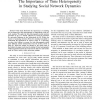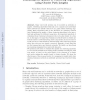159 search results - page 6 / 32 » Small world models for social network algorithms testing |
ESA
2005
Springer
14 years 28 days ago
2005
Springer
Milgram’s experiment (1967) demonstrated that there are short chains of acquaintances between individuals, and that these chains can be discovered in a greedy manner. Kleinberg ...
KDD
2003
ACM
14 years 8 months ago
2003
ACM
In today's industry, the design of software tests is mostly based on the testers' expertise, while test automation tools are limited to execution of pre-planned tests on...
HICSS
2011
IEEE
12 years 11 months ago
2011
IEEE
—This study illustrates the importance of assessing and accounting for time heterogeneity in longitudinal social network analysis. We apply the time heterogeneity model selection...
INCDM
2010
Springer
13 years 6 months ago
2010
Springer
Many real world systems can be modeled as networks or graphs. Clustering algorithms that help us to organize and understand these networks are usually referred to as, graph based c...
GECCO
2009
Springer
14 years 2 months ago
2009
Springer
Size and complexity of data repositories collaboratively created by Web users generate a need for new processing approaches. In this paper, we study the problem of detection of �...


